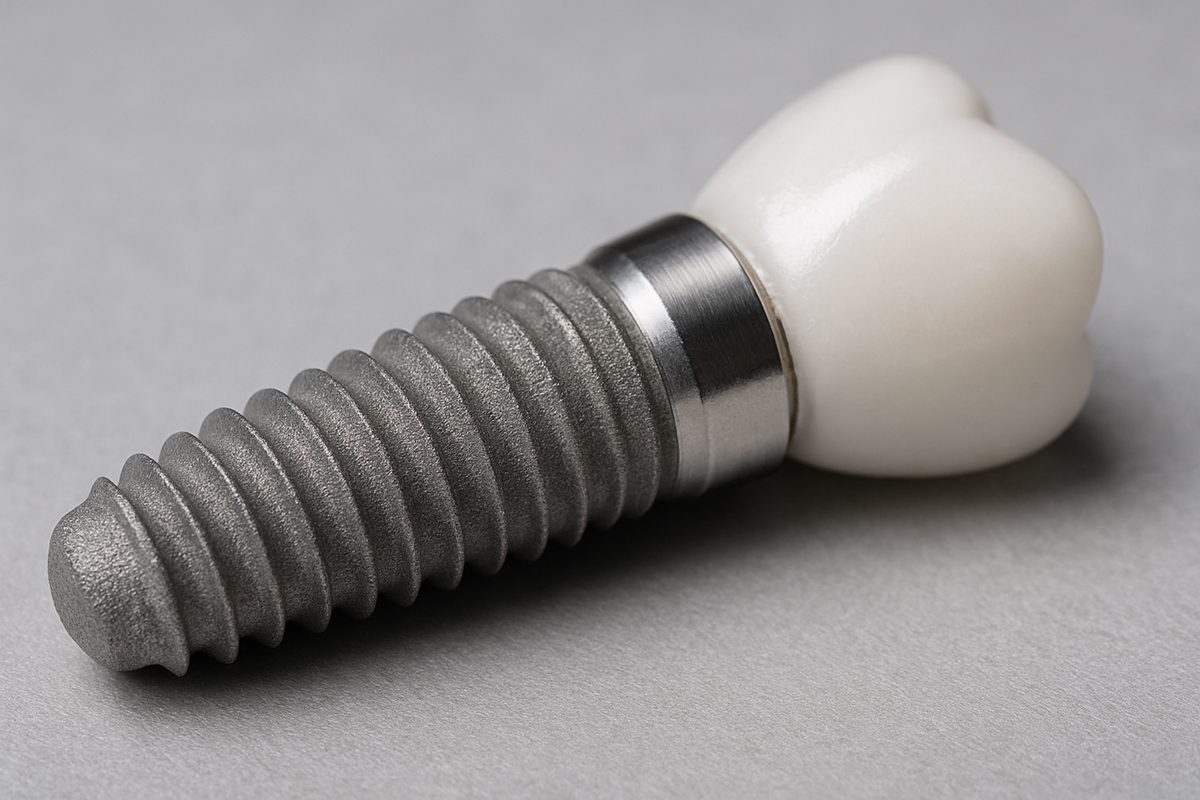If you’ve ever asked “what are implants made of,” you’re not alone. The materials used for dental implants matter for strength, appearance, and long-term health. This short guide explains the common implant materials, how they interact with bone and gum tissue, surface technologies that improve success, and how to choose the best option for your mouth.
Common Materials Used In Dental Implants
Titanium and Titanium Alloys
Titanium is the standard material for dental implants. It’s extremely strong, resists corrosion, and has a long track record of success. Most titanium implants use alloys that add strength while keeping the metal biocompatible. A key reason titanium is favored is its proven ability to fuse with bone — a process called osseointegration — which gives reliable stability for crowns, bridges, and dentures.
Zirconia (Ceramic) Implants
Zirconia implants are a metal-free, ceramic alternative. They are white, which can help with esthetics when gum tissue is thin or recedes. Zirconia is biocompatible and increasingly used for patients who prefer non-metal options or who report metal sensitivity. While zirconia technology has improved, it’s a newer option compared with titanium and may have different clinical indications depending on bite forces and implant location.
How Implant Materials Affect Bone Integration and Healing
Osseointegration is the process where bone grows tightly around the implant. Material chemistry and surface texture influence how bone cells attach and mature. Implants with surfaces designed to encourage bone growth generally integrate faster and more predictably, which improves long-term stability and reduces the chance of failure.
Surface Technologies and Coatings That Improve Success
Manufacturers use several surface approaches to help bone and soft tissue attach:
- Roughened surfaces created by sandblasting or acid etching to increase surface area for bone contact.
- Plasma-sprayed or titanium-coated layers that encourage cell attachment.
- Specialized proprietary textures aimed at improving soft-tissue seal around the gumline.
These technologies do not change the basic material (titanium or zirconia) but they do affect healing speed and long-term outcomes.
Comparing Titanium vs. Zirconia: Pros and Cons
Strength & Durability
Titanium is the most tested and trusted for strength under heavy biting forces, especially in back teeth and full-arch cases. Zirconia is strong but can be more brittle under certain stress patterns. For single front tooth replacements, zirconia often performs well; for some full-mouth reconstructions, titanium remains preferred.
Esthetics & Gum Tissue
Zirconia’s white color can prevent a grayish show-through at the gumline, helping smiles look natural if the gum is thin. Titanium can appear darker if gum tissue recedes, but modern prosthetics and careful planning minimize this risk.
Allergies, Biocompatibility & Patient Choice
True titanium allergy is rare. Patients who worry about metal sensitivity can be tested, and zirconia offers an alternative. Biocompatibility for both materials is high, so choice often depends on esthetic goals, implant location, and the clinical judgment of the implant team.
Cost, Longevity, and Aftercare Differences
Costs vary by material, implant system, and complexity of treatment. Titanium implants often cost less because they are so widely used. Longevity for both materials can be decades with good hygiene and regular dental care. Aftercare is the same: daily brushing, flossing or interdental cleaning around restorations, and routine check-ups. Avoiding tobacco and treating gum disease promptly help implants last longer.
Choosing the Right Material: Why a Specialist Matters
Deciding “what are implants made of” for your smile is best done with an implant-trained specialist. Prosthodontists assess bite forces, gum thickness, bone volume, and esthetic goals to match material to your case. Stuparich & Nouel Dental Associates — led by prosthodontists Dr. Mauro Stuparich and Dr. Alexandra Nouel — use digital planning, CBCT imaging, Laser-Lok® and modern implant systems to select the material and surface technology that fit each patient’s needs. Their experience helps ensure predictable, long-lasting results tailored to your mouth.
Quick FAQ
Can implants cause allergic reactions?
Allergic reactions are rare. Metal sensitivity can be tested if there’s a concern. Zirconia is an option for patients who prefer metal-free restorations.
How long do implants last?
Implants commonly last 20 years or more when well cared for. Lifespan depends on oral hygiene, gum health, bite forces, and regular dental follow-up.
Are ceramic implants a good choice for everyone?
Zirconia can be a great choice for esthetic areas or patients avoiding metal, but it may not be ideal in all high-stress situations. A specialist evaluates whether ceramic or titanium is better for each case.
Closing & Next Steps
Understanding “what are implants made of” helps you ask the right questions about strength, looks, and long-term health. Talk with your dentist or a prosthodontist to review material options for your smile. To explore which implant material fits your needs, schedule a consult with Stuparich & Nouel Dental Associates to discuss materials, digital planning, and a personalized treatment plan.




